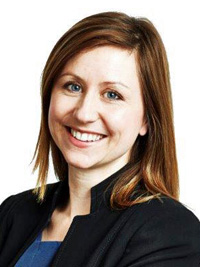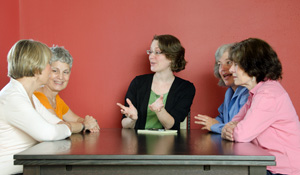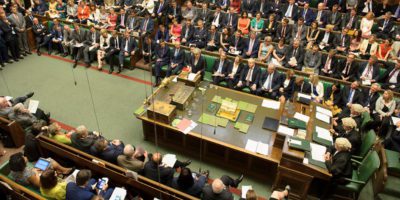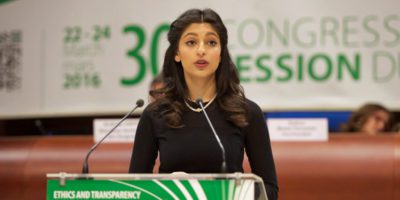Claire Emes is Senior Research Director and Head of Qualitative at Ipsos MORI, with almost 15 years of business focused research delivery, covering both qualitative and quantitative approaches. She has helped a diverse range of organisations better understand people, brands and society. Claire was previously Ipsos MORI’s Chief Innovation Officer, responsible for ensuring the company develops and employs powerful capabilities in evolving research techniques.

“…I’m often asked “how will women vote?” and “what are they looking for?”. I find these questions a bit frustrating as no one ever asks “how will men vote”? Female voters are not a homogeneous group and are never going to deliver a block vote…”
Inherently nosy or maybe just curious
I’m inherently nosy and when I look back, I guess I was destined for a career in opinion research having spent most of my childhood asking questions and wanting to understand what people say and do – and why!
I managed to talk my way into some fascinating work experience in the late 1990s including a week with Tony Blair’s Polling Advisor, the late Philip Gould (I approached him when he gave out the prizes at my comprehensive school in Woking).
Opinion research was therefore an obvious choice when I graduated and I have remained curious in people and culture ever since. Whilst I still enjoy commenting on public opinion, most of the work I do (and indeed Ipsos MORI does) is in the private sector. I’ve been surprised to discover that I enjoy studying how people clean their homes just as much as whom they will vote for!
Working with clever and interesting people
The thing I love most about my job is that there is no “typical day”. One day I’ll be involved in a consumer co-creation workshop to generate insight-led innovation ideas with some of the world’s largest FMCG [fast moving consumer goods] companies.
The next, I’ll be viewing powerful films produced by our Ethnography Centre of Excellence, which are fundamentally changing the way pharmaceutical companies see patients suffering from chronic diseases. A constant, however, is that I get to work with lots of very clever and interesting people.
Trying to understand how people think and act
It’s a fascinating time to be working in research. We’re witnessing a revolution in consumer behaviour driven by people’s changing relationship with technology; it’s fundamentally shifting the way we communicate, work, shop, and entertain ourselves. This presents a challenge to those of us trying to understand how people think and act.

We’re constantly finding new ways to collect data and also to observe and listen to people without even having to ask any questions! I’m extremely passionate about new research techniques, so much so that I once made my own family the subject of a ‘day in the life’ research experiment. That said, it’s easy to suffer from ‘shiny new toy’ syndrome, so we should always question the added value any new technique brings.
The craft of integrating and curating information
Today, there’s so much information available – and budgets are tight – so before diving into primary consumer research, we recommend starting with ‘knowing what you know’ and finding insight gaps. Integrating and curating information has become our craft – we’re uncovering, interpreting, contextualising and socialising intelligence from multiple sources, and then ensuring this is shared and built upon within client organisations.
Sharing insights has become so much more effective now that we use purpose-built tools like our Insight Cloud, which becomes a “living, breathing” ecosystem within our clients’ organisations – a bit like Facebook for research insights! It allows us to communicate research findings in a much more powerful way than a PowerPoint report and transforms information into inspiration.
There are also new and exciting ways to immerse clients in the lives of real people, for example, we’re now using virtual or augmented reality. This allows our clients to build empathy with the people who buy and use their products or are affected by their policy decisions.
Activating or “bringing to life” research results is key to the success of any study so we’re employing more and more experts in data visualisation, design, film production and storytelling.
Seeking a holistic picture of the election campaign
In terms of our political polling (which we’ve been doing rather more of than we were anticipating of late…), we’re supplementing our traditional telephone opinion polls and the face-to-face exit poll, with a range of other qualitative and innovative techniques to explore what’s influencing voters.
For the 2015 election, the BBC commissioned us to run an “Election Uncut” online community to provide a more holistic picture of the election campaign. Through a mix of surveys and qualitative tasks, we were able to explore voters’ experience of the campaign, their attitudes to voting, and the key issues determining how they vote. Crucially it allowed us to probe into how attitudes developed throughout the course of the election campaign.
The Twitter factor
We also explored the world of social media including conducting live analysis of the discussion on Twitter during the leaders’ debates using a new form of social media analysis based on natural language processing. Twitter analysis gave us access to hundreds of thousands of views and opinions during the course of the debates.
However, it is crucial to remember that despite the volume, Twitter is far from representative of the views of the population as a whole; three quarters are under 45 and lower social grades are underrepresented.
Indeed, looking at political conversations specifically, we found that a third of Tweets about Cameron and Miliband over two weekends in the build-up to the 2015 General Election came from just 1% of Twitter users, highlighting the comparatively small number of contributors this conversation actually represents!
Head and heart
For the EU referendum, we used a neuroscience technique called Implicit Reaction Time (IRT) to help us understand not just what people said about the European Union but also with how much conviction they held their views (measured by how quickly they expressed their opinion).
The research gave us an indication of the strength of people’s feelings towards leaving or staying in the European Union and areas of weak association that may indicate differences between what people told us and how they would actually vote. The level of conviction leave voters had that Brexit would be good for the economy, despite the overwhelming interventions from a range of bodies stating the opposite, was an indicator that things perhaps weren’t going to pan out as many of us had expected!
This year, we’re planning to experiment with heart rate variability to capture voters’ subconscious and unconscious attitudes to party leaders, key policies, and voting behaviour. We will again be able to compare explicit responses to more visceral reactions to help explore strength of conviction and potential swing in the run up to the election.
What women want?
I’m often asked “how will women vote?” and “what are they looking for?”. I find these questions a bit frustrating as no one ever asks “how will men vote”? Female voters are not a homogeneous group and are never going to deliver a block vote.

Overall, we don’t see much of a difference in Conservative vote share between men and women, though whilst Labour seems to be holding on to its share among women, it is currently losing with men. Women are just as likely as men to say they are going to vote, and to say that they are definitely decided on whom they are going to vote for.
Women are likely to be making up their minds in the same way as men by looking at parties, leaders and policies but we do some differences by gender in the issues that matter. Women are more pessimistic about the economy than men. The overall pattern of their top issues is similar to men, but with slightly different emphasis: they are slightly less likely to say that Brexit or the economy is important to them, and slightly more likely to cite education or health.
To the general election and beyond…
It’s a busy time at Ipsos MORI; later this month I’ll be chairing an event on Millennials, where we’ll be dispelling some of the myths and confirming some of the realities about the oft maligned generation. As an “original Millennial” (I just about scrape into Gen Y, physically, if not mentally) I’m really looking forward to presiding over this. Our latest Generations research will provide some very useful tips for marketers and policy makers alike!
https://www.ipsos.com/ipsos-mori/en-uk/
https://en-gb.facebook.com/IpsosMORI/
https://www.linkedin.com/company-beta/4320/





